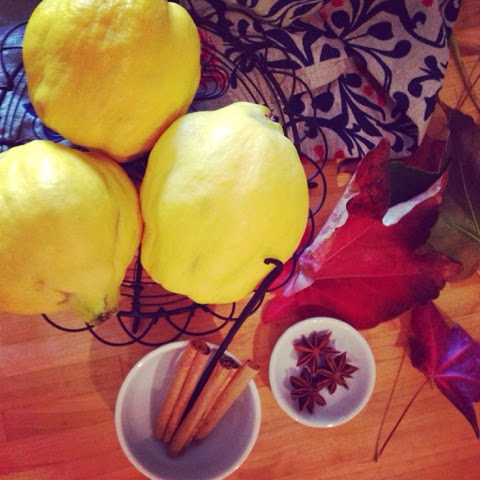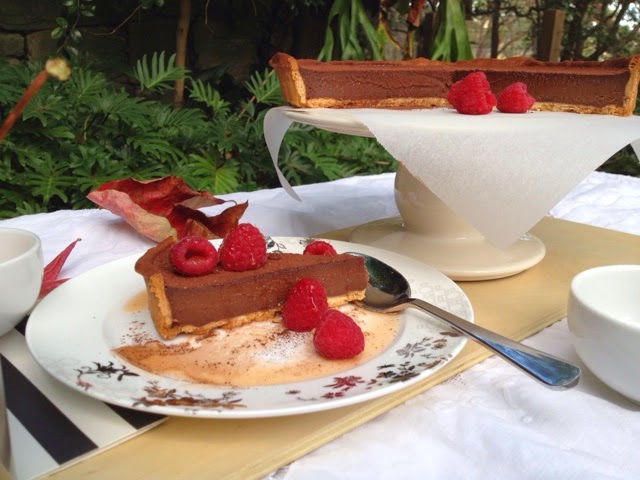Slow-Roasted Quince
Sometimes I get just as excited seeing an empty weekend on our calendar, where the only thing planned is a walk to the local shops for a "cino" and maybe a visit to the park, as when our schedule is jammed with catch-ups.
Time is such a luxury these days, so when I get a large undisturbed chunk of it in winter, one of the most satisfying things to do with it, apart from a colour/cut/blowdry, is to slow-roast something.
It would usually be meaty - a shoulder of lamb or Mr LP's excellent beef stew. But I'm still wearing my tutti frutti pants and serving up all kinds of weird to the kids, so I bought some quinces instead and waited patiently for the weekend to roll around.
In their raw state, quinces are pale, hard and bitter to taste. But when cooked long and slow, their flesh becomes beautifully tender and sweet, and it transforms into a deep, earthy orange colour. They taste like the country, if you know what I mean. Kind of somewhere between an apple and a strong pear, and they go superbly with classic baking flavours like vanilla, citrus, and almond.
For my basic roasted quince, I turned to the quince queen, Maggie Beer, for inspiration. Maggie roasts her quince for seven hours, which was a little too much oven hogging time in my kitchen, so I had to tweak.
Here's what I did:
Roasted Quince with Cinnamon and Orange
(Recipe adapted from Maggie's Kitchen)
Three large quince, peeled and cut into large wedges (reserve the peel)
Juice of two lemons
One orange, zest peeled in wide strips, plus juice
One cinnamon stick
Two vanilla beans, split and seeds scraped out
Two star anise
400g caster sugar
600ml water
Preheat oven to 150C.
Place quince pieces in a bowl and squeeze over the lemon juice. Set aside.
Tie quince peel and orange peel strips together with kitchen twine and place in a medium sized saucepan with water, caster sugar, cinnamon, orange juice, star anise, vanilla beans and scraped seeds.
Bring to a boil and simmer on medium heat until syrupy (about 10 mins). Remove the twine and zests.
Place quince pieces in a baking dish along with syrup, including cinnamon stick, vanilla beans and star anise.
Cover closely with a piece of baking paper, cut to fit the inside of the baking dish.
Roast for two hours, then turn the quinces and return to the oven for a further one to two hours, depending on your taste and whether you want the quince to be a blushing pink, deep orange or dark crimson. The longer you bake them, the deeper the colour and intensity of flavour.
Keep the fruit and syrup in a container in the fridge until ready to use. It will last about a week to 10 days.
It would be perfectly fine to stop here, and serve these blushing beauties warm, drizzled with their syrup and a generous scoop of vanilla ice cream.
They are also wonderful on porridge for breakfast or you could include them as part of a brekkie parfait, layered with vanilla yoghurt and hazelnut granola.
Here are three other ways I put them to use:
Quince and Almond Tarts
(Makes 12 small tarts or one large tart)
Six large pieces of roasted quince, thinly sliced
Frangipane:
125g butter, melted
3/4 cup almond meal
1 cup icing sugar
1/4 cup self-raising flour
Zest of 1/2 lemon
3 egg whites
Pastry:
250g plain flour
50g icing sugar (powdered sugar)
125g cold butter, cubed
1 egg, lightly beaten
Dash of milk
For Pastry:
Place flour and icing sugar in a food processor and blitz until combined.
Add cubed butter and pulse until the mixture resembles fine breadcrumbs.
Whisk the egg and milk together and add to the processor while the motor is running.
Pulse until the mixture just comes together to form a dough.
Wrap dough in plastic wrap and place in the fridge for at least 30 minutes.
For Frangipane:
Sift flour and icing sugar into a large bowl. Stir in almond meal and lemon zest.
Add egg whites and stir until combined, then carefully stir in melted butter.
Preheat oven to 180C.
Roll dough out on a lightly floured surface to form a rectangle, about 3mm thick, enough to cover the base and sides of a long rectangular loose bottomed fluted tart tin. Press to the edges and trim any excess. If making small tarts, cut out circles with a pastry cutter and press into a 12-hole muffin tin.
Place tin in the freezer for 5 minutes. This will help to prevent shrinkage when the tart bakes.
If making a large tart, blind bake with pastry weights and baking paper for 8 mins, then remove baking weights and bake for a further 8 mins or until tart shell is light golden.
If making small tarts, blind baking isn't necessary. Just bake the tart shells for 10 mins until light golden.
Reduce oven temperature to 165C.
**Because I sometimes have things like left-over salted caramel in my fridge, and just happened to on the day I baked these, I added a teaspoon of caramel in the bottom of each tart. If you have any around, or care to make the caramel in the pudding recipe following, I highly recommend this step.
Pour frangipane into the tart shell(s) and arrange slices of quince along the top.
If making a large tart, bake for 20-25 mins or until puffed and golden brown.
For small tarts, bake for 18-20 mins.
Cool slightly before serving with a light dusting of icing sugar.
Quince Butterscotch Pudding
1 1/2 cups slow roasted quince, sliced
125g butter, melted
3/4 cups caster sugar
1/2 teaspoon vanilla extract
2 eggs
1 1/2 cups self-raising flour
1/2 cup milk
Butterscotch:
75g caster sugar
65g butter, cubed
1/4 cup cream
For butterscotch, place caster sugar in a saucepan over medium-high heat and melt without stirring. Tilt the saucepan to spread the molten sugar around the pan surface to ensure it all melts without burning.
When the toffee begins to bubble, carefully add the butter and cream. Take care as mixture will spit.
Turn off the heat and stir until all combined and a nice caramel colour (about 1 minute).
Set aside to cool.
Preheat oven to 160C.
Spray the bottom of a medium sized pudding dish with non-stick baking spray.
For pudding, mix all ingredients except quince in a large mixing bowl until combined.
Pour the butterscotch into the bottom of the pudding dish. Place quince slices on top.
Cover the quinces and caramel with the pudding batter, spreading gently to the edges with a spatula.
Place the pudding dish inside a large roasting tray. Pour warm water into the roasting tray until it reaches half-way up the side of the pudding dish.
Bake for 45-55 mins until puffed and golden. If you think pudding is browning too much on top, cover with foil at around the 40 minute mark.
Dust lightly with icing sugar and serve with cream or custard.
Chocolate tart with Quince Vanilla Bean Syrup
Pastry:
250g plain flour
50g icing sugar (powdered sugar)
125g cold butter, cubed
1 egg, lightly beaten
Dash of milk
Tart:
300g quality dark chocolate, chopped
100g quality milk chocolate, chopped
400ml cream
2 eggs, lightly beaten
Quince Syrup:
3/4 - 1 cup of syrup reserved from roasted quince recipe above
Preheat oven to 180C.
Place flour and icing sugar in a food processor and blitz until combined.
Add cubed butter and pulse until the mixture resembles fine breadcrumbs.
Whisk the egg and milk together and add to the processor while the motor is running.
Pulse until the mixture just comes together to form a dough.
Wrap dough in plastic wrap and place in the fridge for at least 30 minutes.
Roll out to 2mm thickness and press into a 23cm round, loose-bottomed tart tin.
Blind bake for 8 mins, then remove baking weights and continue baking for a further 10mins until tart shell is light golden. Set aside to cool in tin.
Reduce oven to 130C.
Pour tart filling carefully into the tart shell and return to the oven with a steady hand for 30-35mins or until just set and filling has a slight wobble in the centre.
Refrigerate until cold and completely set.
When ready to serve, remove tart from tin, place on serving plate and dust with quality cocoa.
When ready to serve, remove tart from tin, place on serving plate and dust with quality cocoa.
Cut tart with a hot knife and serve drizzled with quince syrup and thick cream.
Tart Filling:
Place chopped chocolate into a heat-proof bowl and set aside.
Heat cream in a saucepan until boiling point and pour over the chocolate. Leave for 3-4 mins and then stir very gently until the mixture combines into a smooth ganache.
Stir in beaten eggs.









I rarely find a quince, but next time I get my hands on some, I know where to turn for some recipes and ideas! Thanks!
ReplyDeleteMy pleasure Jean! They're a nice alternative to apples and pears in winter.
Delete